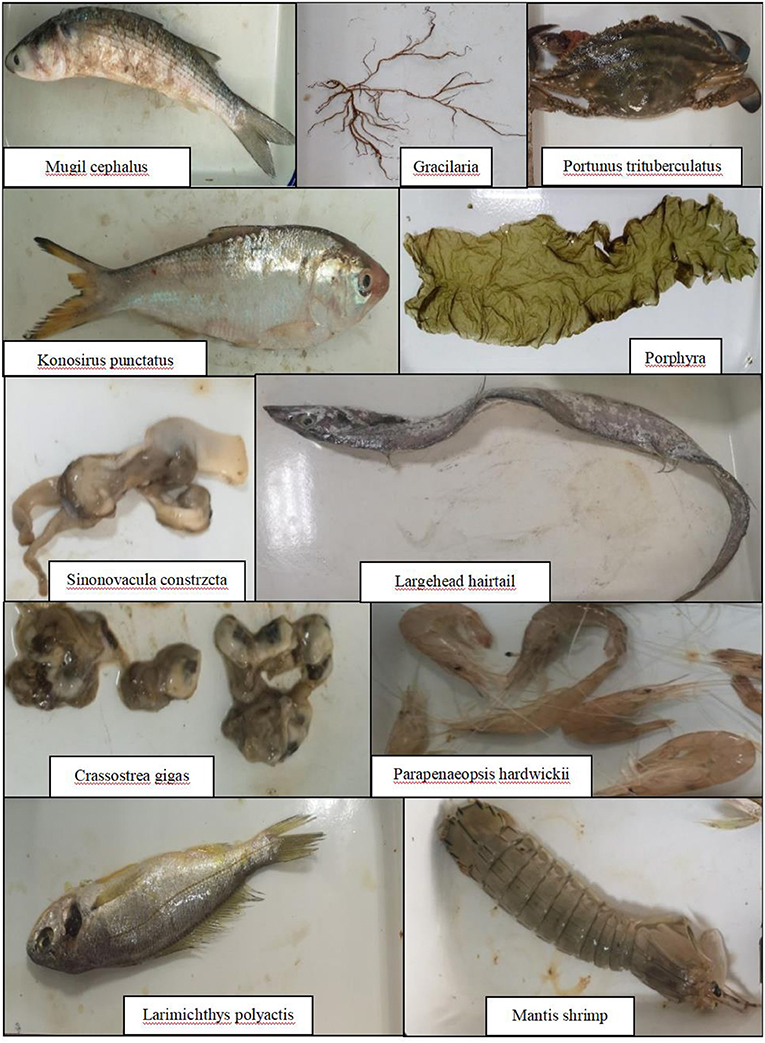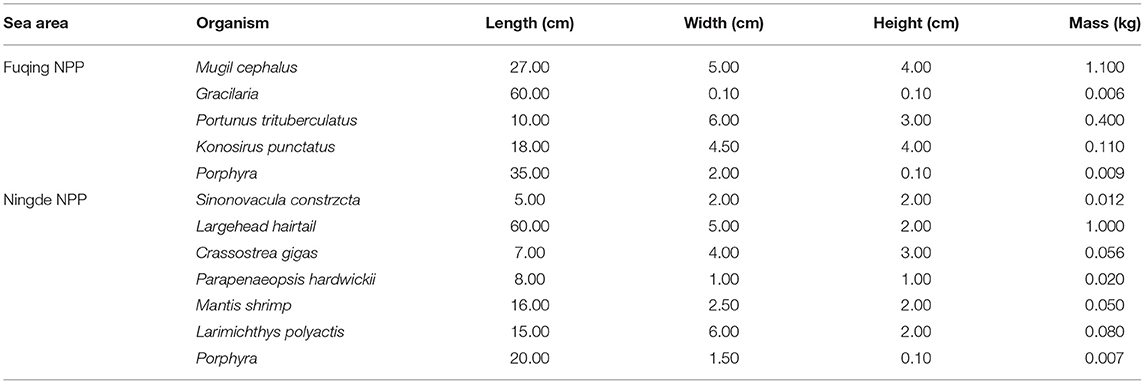- 1Institute of Marine Sciences, Shantou University, Shantou, China
- 2Laboratory of Marine Isotopic Technology and Environmental Risk Assessment, Third Institute of Oceanography, Ministry of Natural Resources, Xiamen, China
- 3School of Marine Sciences, Nanjing University of Information Science and Technology, Nanjing, China
- 4Southern Marine Science and Engineering Guangdong Laboratory, Guangzhou, China
With the rapid development of nuclear power, the radiation impacts on edible marine organisms, and the potential radiation risks to humans have become of considerable concern to public health. In this study, the activities of 210Po and 210Pb as well as those of other radionuclides in fishes (Mugil cephalus, Konosirus punctatus, Largehead hairtail, and Larimichthys polyactis), crustaceans (Mantis shrimp, Parapenaeopsis hardwickii, and Portunus trituberculatus), bivalves (Crassostrea gigas, Sinonovacula conzcta), and macroalgae (Gracilaria, Porphyra) collected in the coastal area adjacent to the Fuqing and Ningde nuclear power plants (NPPs) were determined. The activity range of 210Po and 210Pb was 0.60–48.09 and 0.07–2.76 Bq/kg freshweight, respectively, with 210Po/210Pb activity ratios of 1.1–189.7. The ranking of 210Po activity levels in marine organisms was bivalve mollusks > crustaceans > fishes > macroalgae. The calculated bioconcentration factors of 210Po and 210Pb were 636–44,944 and 3–1,226 L/kg, respectively. These values provide a new supplement to the IAEA reference database. The radiation dose rates for these marine organisms ranged from 0.037 to 1.531 μSv/h, which was much lower than the ERICA ecosystem screening benchmark of 10 μGy/h. The calculated committed effective dose received by humans from ingestion of these marine organisms was 0.06–2.99 mSv. Overall, 210Po was the dominant radiation dose contributor in marine organisms and humans, whereas the dose contributions from the artificial nuclides 90Sr and 137Cs were negligible.
Introduction
The polonium isotope 210Po (half-life, T1/2 = 138.4 d) and its grandparent 210Pb (T1/2 = 22.26 y) are nonconservative, naturally occurring radionuclides within the uranium 238U decay chain, which is ubiquitous in the environment of the earth. The isotopes 210Po and 210Pb in the atmosphere mainly originated from the release of 222Rn from the ground and its subsequent decay. Due to their strong particle reactivity, they are firmly attached to the aerosol soon after they are produced. With the dry and wet depositions, they are subsequently discharged into the terrestrial and marine environment via dry and wet deposition (Seiler and Wiemels, 2012). Due to their unique geochemical properties, 210Po and 210Pb are used as a tracer pair to study the dynamic processes of aerosols in the atmosphere and estimate the residence times of aerosols (Aba et al., 2020). They are also used to study particle scavenging processes in the sea, particularly in assessing the export of particulate organic carbon (POC) fluxes from the euphotic zone (Zhang et al., 2020; Bam and Maiti, 2021), as well as specific marine food chain processes (Strady et al., 2015). Indeed, beyond the oceanographic application of 210Po and 210Pb, their accumulation in marine organisms and transfer to human consumers of seafood, and the resulting radiation doses to marine organisms or committed effective doses to humans are also issues of public concern. This is especially true for 210Po, as it is one of the most radiotoxic nuclides that emit high-energy (~5.3 MeV) alpha rays and is the main contributor of the radiation dose received by marine organisms and humans (UNSCEAR, 2000; Sivakumar, 2014; Men et al., 2020a,b).
Marine organisms usually concentrate 210Po and 210Pb from the marine environment. Although the activity levels of 210Po and 210Pb in the marine environment are relatively low compared with those in the terrestrial environment, different marine organisms can concentrate these two radionuclides to relatively high levels with high concentration factors (CFs) (~102 to ~105) (IAEA, 2004). Therefore, 210Po and 210Pb provide the main radiation source for marine organisms. In seawater, there are relatively higher levels of other naturally occurring nuclides, such as uranium 238U (12.2–215.4 Bq/m3), radium 226Ra (0.22–7.20 Bq/m3), and potassium 40K (~12,000 Bq/m3), and artificial radionuclides, such as cesium 137Cs (<3.2 Bq/m3) and strontium 90Sr (<2.2 Bq/m3) (IAEA, 2005; Liu, 2010). Marine organisms also concentrate these nuclides in their body, which thus also produce self-radiation. Since the 1980s, the concept of human-centered environmental protection has gradually evolved into the concept of ecological protection in which the whole ecosystem is the protection target within the field of radiation protection. Many international organizations and government departments have been studying the effects of ionizing radiation on nonhuman species, including the International Commission on Radiation Protection (ICRP), the International Atomic Energy Agency (IAEA), the United Nations Scientific Committee on the Effects of Atomic Radiation (UNSCEAR), and the European Commission (EC). Additionally, after the 2011 Fukushima Dai-ichi Nuclear Power Plant (FDNPP) accident, the rapid development of nuclear power has raised increasing attention to the radiation impacts on marine organisms and the potential radiation risks to public health (Yu et al., 2018; Men et al., 2020a,b).
At present, the Fuqing and Ningde Nuclear Power Plants (NPPs), located on the coast of Fujian province (Figure 1), are in operation. The marine organisms living in the area adjacent to these two NPPs provide ideal experimental test subjects to study the concentrations of radionuclides in the marine environment as well as to undertake radiation dose assessment. In this study, data are provided on the activity levels of naturally occurring and artificial radionuclides in marine organisms used as bio-monitors of nuclear power plant operations. Activity levels of 210Po, 210Pb, and other naturally occurring or artificial radionuclides were investigated in fish, crustaceans, bivalve mollusks, and macroalgae in the areas surrounding Fuqing and Ningde NPPs, and the resulting radiation doses to both marine organisms and humans were assessed.
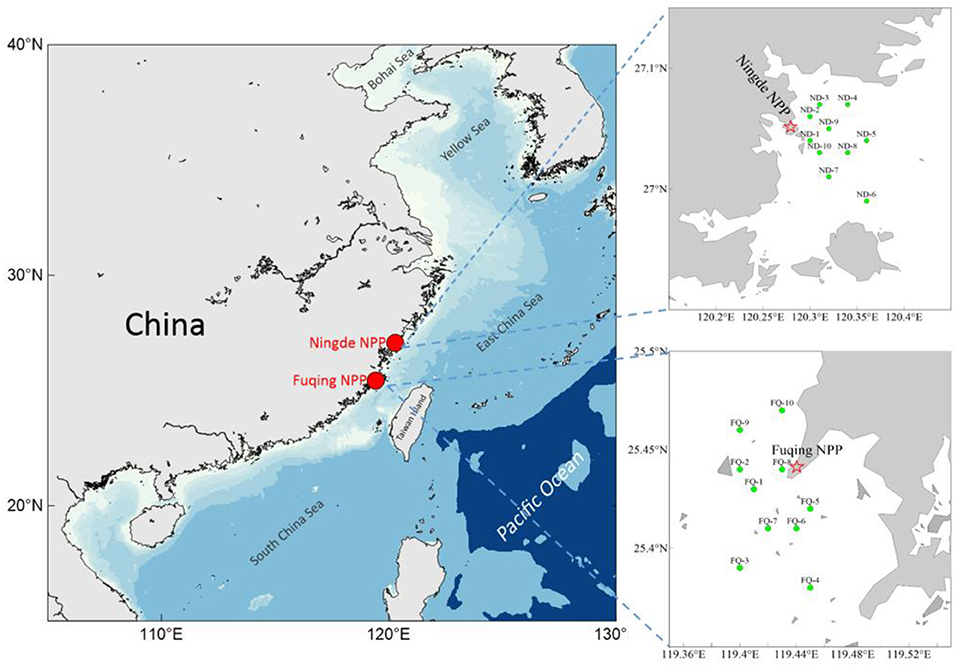
Figure 1. Sediment and water sampling stations (green symbols) near the Fuqing and Ningde nuclear power plants along the coast of China.
Materials and Methods
Sample Collection
Samples of marine organisms were obtained by hired fishermen in areas adjacent to Fuqing and Ningde NPPs (i.e., within 10 km) in July 2020 (Figure 1). Twelve samples with a fresh weight of ~2.2–10.6 kg each were collected. They were refrigerated and immediately sent to the laboratory (within 24 h). Marine organisms include fishes (the mullet Mugil cephalus, Konosirus punctatus, Largehead hairtail, and Larimichthys polyactis), crustaceans (Mantis shrimp, Parapenaeopsis hardwickii, and crab Portunus trituberculatus), bivalves (soft tissues of the Pacific oyster Crassostrea gigas, and razor clam Sinonovacula conzcta), macroalgae [the red algae Gracilaria spp. (Gracilariaceae) and Porphyra spp. (Bangiaceae)] (Figure 2). Seawater and sediment samples were also collected at each of 10 stations near Fuqing NPP and Ningde NPP (Figure 1).
Sample Processing and Analysis
The weighed marine organism samples were dried to constant weight for 48–96 h at 60°C in a drum dryer. Dried samples were pulverized, using agate mortar and pestle sets in preparation for the radioactive analysis. About 1 g of these pulverized dry samples was used for the measurement of 210Po, using α spectrometer (Canberra 7200) (Štrok and Smodiš, 2011). The rest was transferred into crucibles and ashed in a muffle furnace at 450°C for 24–40 h. The ashes were ground and weighed at room temperature, stored in sealed boxes (~100 g per sample) for 20 days until analysis. Canberra BE6530 and GR4021 HPGe spectrometers were used to determine the activities of 210Pb, 134Cs, 137Cs, 110mAg, 238U, 226Ra, and 40K (Men et al., 2017). The di (2-ethylhexyl) phosphoric acid (HDEHP) extraction-β counting method and the Ortec MPC-9604 α/β counter were employed for 90Sr analysis (Men et al., 2017), using ~10 g of the ashes. Seawater and sediment samples were also analyzed according to the Technical Specification for Marine Radioactivity Monitoring (State Oceanic Administration of China, 2011). All marine organisms were analyzed whole, except for the bivalves whose shells were removed. Parallel sample analysis was implemented for Konosirus punctatus and Mantis shrimp; the results were in good agreement within an error <3%.
Specifically, ca. 1 ml of 0.12848 Bq/ml 209Po was added to 1 g of a dry biological sample, and then the spiked sample was digested with a mixture of concentrated nitric acid and hydrogen peroxide. After steaming until nearly dry, 2 mL of concentrated hydrochloric acid (HCl) was added and steaming carried out again, and the residue was dissolved with 2-M HCl. After filtration, the filtrate was placed in an α spectrometer for measurement over 24 h. The chemical yield for 209Po ranged from 52 to 89%, averaging 72 ± 12% (SD, n = 14) after adding 1 ml of 0.12848 Bq/ml of 209Po standard solution.
Seawater (5 L) was taken from each station for analysis. A known amount of 209Po (~1 g) was added to the seawater samples to determine the yield. The spiked samples were co-precipitated with ferric hydroxide by adding ~50 mg of Fe3+ and adjusting the pH to ~8, with the addition of concentrated ammonium hydroxide (NH4OH). The precipitate was then dissolved in concentrated HCl, and auto-deposition was carried out. The analysis of other radionuclides in seawater is described in detail by Men et al. (2017).
Radiation Dose for Marine Organisms
The ERICA assessment tool (version 1.3, Tier 2) was used to evaluate the dose rates for marine organisms (Beresford et al., 2007; Men et al., 2020a,b). The average biological parameters of the specimens sampled, including length, width, and height, as well as weight, are listed in Table 1, and were used to calculate the radiation doses listed (the biological parameters were determined for all individuals of each species in the sample). The average nuclide activities in seawater and sediment were used to estimate the external dose rates. The activity levels of these nuclides in the marine organism were used to estimate the internal dose rates. The low beta, beta/gamma, and alpha weighing factors were taken to be 3, 1, and 10, respectively. The other parameters were set to their default values.
Committed Effective Dose for Humans Consuming Various Marine Organisms
After ingestion or inhalation by humans, some radionuclides persist in the body and irradiate various tissues for many years. The resulting total effective dose over a lifetime (70 years or number of years up to reaching age, 70 for infants, 50 years for adults) is the committed effective dose (ICRP, 2007; Men et al., 2017). This dose received by a human per unit intake (1 Bq) of a given radionuclide is the radionuclide-specific dose coefficient (DC) for ingestion (Fisher et al., 2013), which converts the energy emitted from the ingested radionuclide into a radionuclide-specific, committed effective dose for human adults (Sv). For calculation of the committed effective dose for ingestion of marine organisms in this study, the ingestion rate was assumed as exact ingestion rates were not available. Here, the mean per capita consumption rate of aquatic products in China (50.97 kg/year) in 2018 was used to estimate the committed effective dose (FAOSTAT, 2018). This was calculated by multiplying the radionuclide activity in the marine organism (Bq/kg freshweight) by the ingested mass (kg) and the DC (Sv/Bq) (ICRP, 2012).
Results and Discussion
Activity Levels of 210Po and 210Pb and Other Radionuclides in Marine Organisms
The activities of 210Po and 210Pb as well as other radionuclides in marine organisms from the coastal area adjacent to Fuqing and Ningde NPPs are listed in Table 2; 210Po and 210Pb activities ranged from 0.60 to 48.09 Bq/kg freshweight and 0.07 to 2.76 Bq/kg freshweight, respectively. These values are within the reported ranges of 210Po and 210Pb in marine organisms in China (210Po: 0.117–65.8 Bq/kg freshweight; 210Pb: 0.02–6.88 Bq/kg freshweight) (Li et al., 2016, 2018; Lin et al., 2016; Dong et al., 2018; Lin, 2018). The limit of 210Po activity recommended in fish, meat, and shrimp by the Chinese National Standard on limited concentrations of radioactive materials in foods (GB 14882-94) is 15 Bq/kg freshweight (Ministry of Health of the People's Republic of China, 1994). About 50% of 210Po activities in marine organisms reported in the present study exceeded this value. Most 210Po activities were higher than the UNSCEAR representative 210Po activities in marine fish, crustaceans, and mollusks (2.4, 6, and 15 Bq/kg freshweight) (UNSCEAR, 2000). The activity levels of 210Po varied greatly among the different marine species. For example, the highest and lowest 210Pb activities were measured in Crassostrea gigas and Porphyra, respectively. In general, 210Po activities in marine organisms ranked in the order bivalves > crustaceans > fishes > macroalgae.
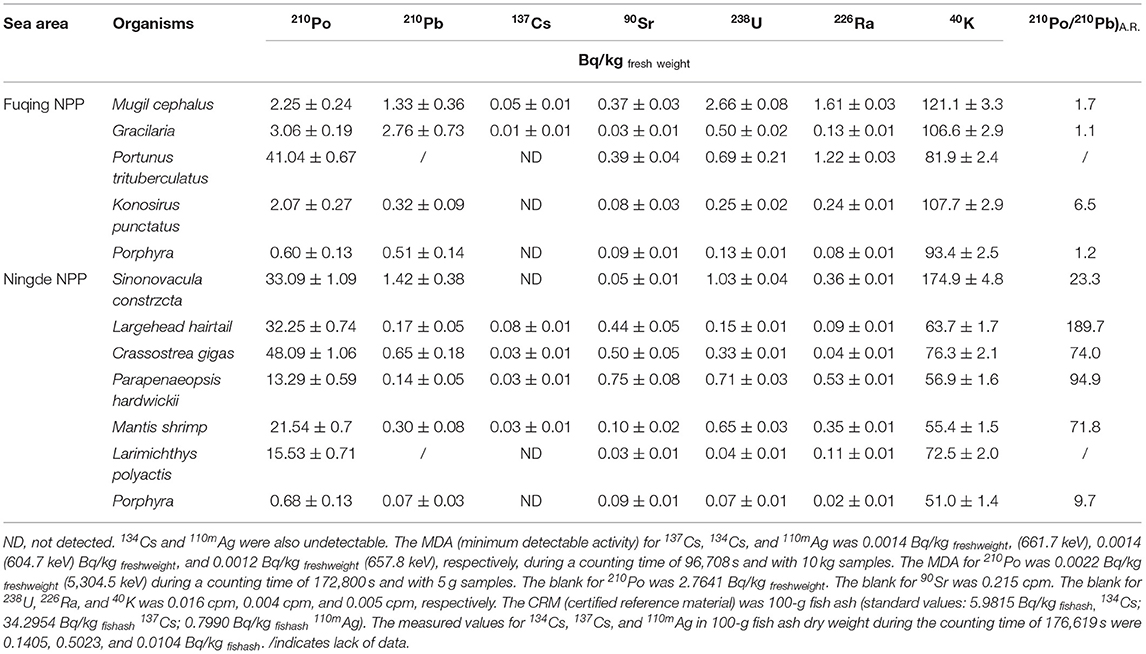
Table 2. Activities of 210Po and 210Pb and other radionuclides in marine organisms sampled in this study.
The accumulation of 210Po in marine organisms is related to food type, life cycle stage, trophic level, and body size (Carvalho, 2018). Firstly, suspension-feeding bivalves are primary consumers that mainly ingest phytoplankton and detrital particulate organic matter. Crustaceans are opportunistic secondary consumers that mainly ingest benthic organisms. Biomagnification can significantly enhance the 210Po activity level in bivalves (Fowler, 2011; Dong et al., 2018). Secondly, bivalves that usually live on the bottom showed higher 210Po activities due to rapid bottom deposition and biological adsorption. The higher 210Po level in their bodies has been attributed to bioconcentration (Sirelkhatim et al., 2008; Lin, 2018). Finally, 210Po is typically more concentrated in the digestive tract and hepatopancreas or in the gonads (Carvalho, 2018; Dong et al., 2018; Hurtado-Bermudez et al., 2019). The 210Po/210Pb activity ratios in the present study ranged from 1.1 to 189.7 (Table 2). It is reported that both 210Po and 210Pb bind strongly to organisms, and that 210Pb is preferably associated with the mineral fractions of bones and shells. Compared with 210Pb, 210Po is primarily associated with proteins in organisms and can penetrate the cell cytoplasm. Therefore, 210Po can be more effectively assimilated in marine organisms than 210Pb, resulting in 210Po/210Pb activity ratios >1 in most marine organisms (Stewart et al., 2008).
As shown in Table 2, the activities of 137Cs, 90Sr, 238U, 226Ra, and 40K ranged from undetectable to 0.08,0.03–0.75,0.04–2.66,0.02–1.61, and 51.−174.9 Bq/kg freshweight, respectively. The activity levels ranked in the order 40K > 210Po > 210Pb > 238U > 226 Ra > 90Sr > 137Cs. The activity levels of 90Sr and 137Cs in marine organisms were ~10−2 to ~10−1 Bq/kg freshweight, which is within background levels (Liu and Zhou, 2000; Chen et al., 2003; Zhang, 2015; Lou et al., 2018). Those of 90Sr and 137Cs activities in fish, meat, and shrimp established by the Chinese National Standard on limited concentrations of radioactive materials in foods are 290 and 800 Bq/kg freshweight, respectively (Ministry of Health of the People's Republic of China, 1994). The radioisotope 210Po is the major natural decay product from the uranium series and provides the largest radiation dose to the human body via consumption of marine organisms (UNSCEAR, 2000; Carvalho, 2011; Khot et al., 2021; Kong et al., 2021). Indeed, the scavenging rate of 210Po is higher than that of other radionuclides in the atmospheric environment (Alam and Mohamed, 2011), resulting in high 210Po deposition in the marine environment. In turn, marine organisms show a stronger affinity for 210Po than for other radionuclides (Bogdan, 1997; Lin, 2018), resulting in a higher activity level of 210Po than that of other radionuclides. The activity levels of 90Sr and 137Cs in marine organisms in the present study are far below these values. The average activities of 210Po and 210Pb as well as other radionuclides in seawater and sediment in the sea area adjacent to Fuqing and Ningde NPPs are listed in Table 3. The data in Tables 2, 3 were used to estimate the radiation doses for the corresponding marine organisms.
Bioaccumulation of 210Po and 210Pb and Other Radionuclides in Marine Organisms
The bioconcentration factor is defined as the activity ratio of a radionuclide in the marine organism or biota to that in ambient seawater (L/kg) and is an indicator of the accumulation capacity of a given organism for a particular nuclide (Arnot and Gobas, 2006; Alava and Gobas, 2016; Ishii et al., 2020). Bioconcentration factors in different radionuclides vary widely due to their different biochemical properties, while bioconcentration factors (BCFs) in different marine organisms differ greatly due to their different bioaccumulation capacities. Even within the same species, BCFs vary among individuals due to differences in physiology, microhabitat, etc. For the sake of convenience and standardization, a set of values for different radionuclides and different kinds of marine organisms was recommended by the IAEA (Table 4) (IAEA, 2004). Using the data for seawater and marine organism samples in the present study, the BCFs of 210Po and 210Pb as well as those of other radionuclides can be estimated (Table 4). The BCFs for 210Po and 210Pb were in the ranges 636–44,944 and 3–1,226, respectively. BCFs of 137Cs, 90Sr, 238U, 226Ra, and 40K were in the range 5–55, 41–1,014, 1–79, 7–479, and 4–15 L/g freshweight, respectively. The BCF data reported in this study provide a useful supplement of information for the IAEA database.
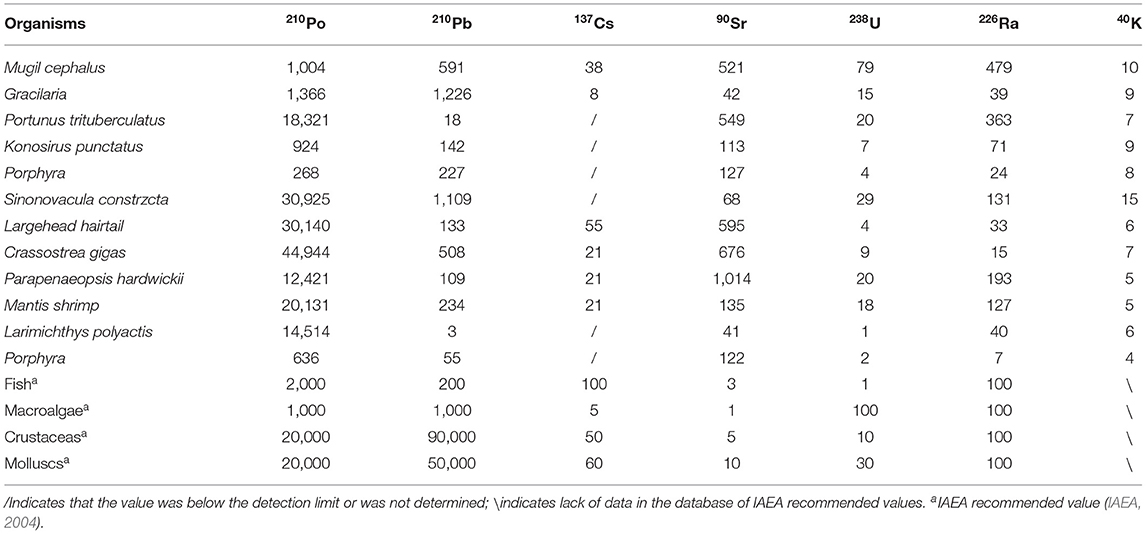
Table 4. Bioconcentration factors of 210Po and 210Pb and other radionuclides in marine organisms sampled in this study.
Radiation Dose Assessment
The radiation doses for nonhuman species have become an issue of increasing public health concern. The ERICA tools downloaded freely from the internet are widely used for radiation assessment (Garnier-Laplace et al., 2011; Johansen et al., 2015; Men et al., 2017, 2020a,b). As shown in Tables 1–4, the radiation doses received by marine organisms in the studied area were assessed, using the ERICA tools. The internal and external dose rates derived for each radionuclide and the total radiation dose rates are listed in Table 5. The total dose rates ranged from 0.037 to 1.531 μSv/h. Around the Ningde NPP, the highest and lowest radiation doses were observed in Crassostrea gigas and Porphyra, respectively. Overall, these values are markedly lower than the ERICA ecosystem screening benchmark of 10 μGy/h (Beresford et al., 2007) and the most conservative safety benchmark, which is one to two orders of magnitude lower than the International Commission on Radiological Protection (ICRP)-derived reference levels for corresponding reference animals or plants (ICRP, 2008; Fisher et al., 2013; Men et al., 2017). This suggested that there are no irradiation effects on marine organisms in the area adjacent to Fuqing and Ningde NPPs.

Table 5. Internal and external radiation dose rates derived for each radionuclide for the different marine species sampled in this study (in μSv/h).
The dose contributions of different nuclides in different species were plotted in Figure 3 and show that 210Po was the dominant dose contributor except for Mugil cephalus and Porphyra (Fuqing NPP) (47–97%), while 226Ra and 40K were the main dose contributors for Mugil cephalus and Porphyra (Fuqing NPP), respectively. The contribution from external and internal doses for each nuclide (Table 5) suggests that the internal doses were much greater than the external doses. In general, the greatest internal dose should be from 210Po sources because of its alpha emissions. Additional main contributors should be 226Ra and 238U, which produced intermediate internal doses because of alpha emissions. Due to high-activity levels in seawater (~11,500 Bq/m3) and marine organisms (51−174.9 Bq/kg freshweight) as well as emitted high-energy γ-rays (1,460 keV), 40K generated much higher internal and external dose rates than 210Pb, 137Cs, and 90Sr (EI-Arabi, 2007). Indeed, the dose contribution from 137Cs and 90Sr was <0.13%, which was extremely low compared to that of naturally occurring radionuclides.
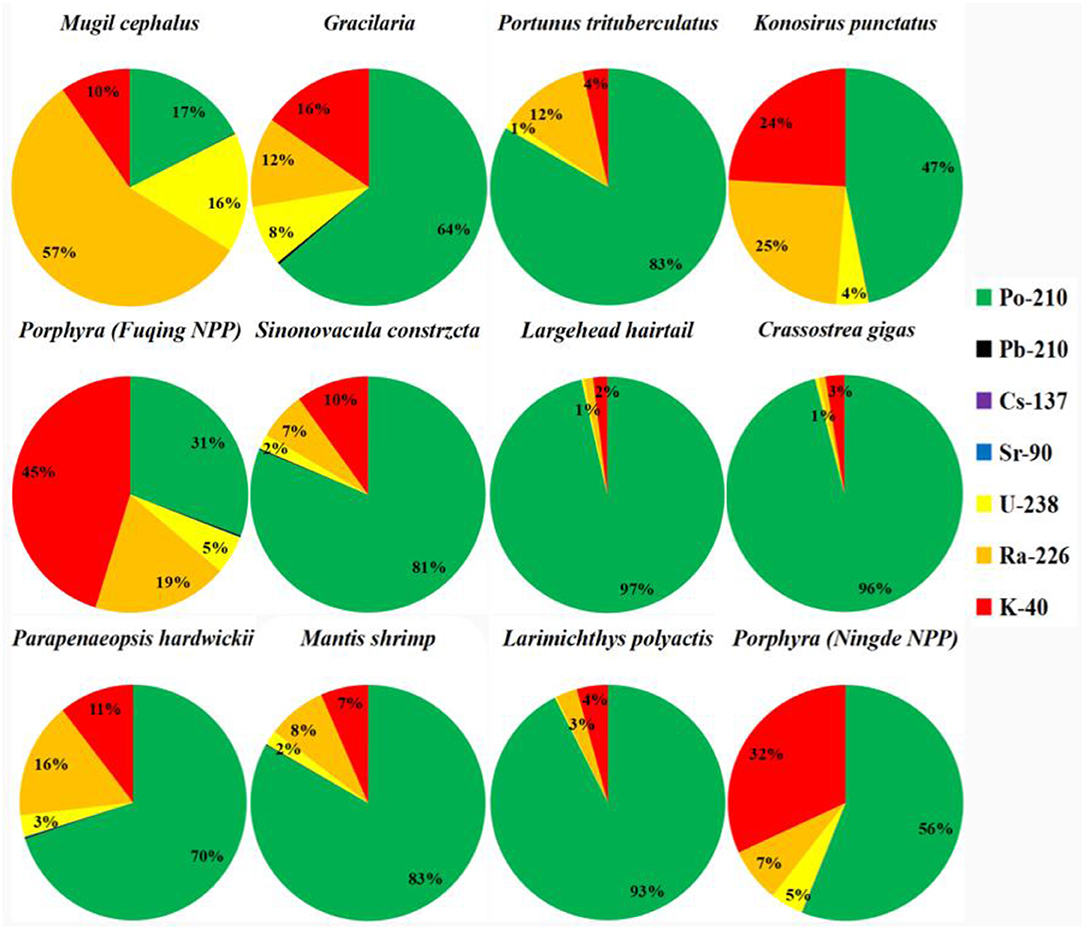
Figure 3. Dose contributions of each radionuclide for the different marine organisms sampled in this study.
Radiation Dose Assessment for Humans
The calculated committed effective dose for humans from ingestion of marine organisms in the area adjacent to Fuqing and Ningde NPPs was 60.74–2,990.41 μSv (Table 6). Results show that a maximum committed dose of 2.99 mSv will be received over the following 50 years based on assumed consumption of 50.97 kg of these marine organisms in 1 year. In terms of species, Porphyra had the lowest committed effective dose to humans (<100 μSv), while Portunus trituberculatus, Sinonovacula constrzcta, Largehead hairtail, Crassostrea gigas, and Mantis shrimp had committed effective doses exceeding 1,000 μSv. Crassostrea gigas produced radiation doses close to 3,000 Sv. The contribution of 210Po to these committed effective doses was 43–99%. Based on this assumed consumption, the committed effective dose in 1 year (~0.06 mSv) was far below the 1-m Sv standard (Ministry of Environmental Protection of China, 2002). It is, therefore, safe to consume these marine organisms. The contributions of different nuclides ranked in the order 210Po > 210Pb/40K > 226Ra > 238U > 90Sr > 137Cs, where 210Po was the dominant contributor to the committed effective dose at 43–99%. In contrast, the artificial nuclides 90Sr and 137Cs contributed only 0.03–2.2%, and thus made the lowest contribution. This suggests that the committed effective dose from anthropogenic nuclides 90Sr and 137Cs is negligible when the NPPs are in operation.

Table 6. Committed effective dosea to humans (in μSv) from the ingestion of various marine organisms (annual consumption).
Conclusions
The activity levels of 210Po and 210Pb in fishes (Mugil cephalus, Konosirus punctatus, Largehead hairtail, Larimichthys polyactis), crustaceans (Mantis shrimp, Parapenaeopsis hardwickii, Portunus trituberculatus), bivalve mollusks (Crassostrea gigas, Sinonovacula conzcta), and macroalgae (Gracilaria, Porphyra) collected in coastal waters adjacent to Fuqing and Ningde NPPs were in the range 0.60–48.09 Bq/kg freshweight and 0.07–2.76 Bq/kg freshweight, respectively. The activity ratios of 210Po/210Pb were in the range 1.1–189.7; calculated BCFs of 210Po and 210Pb in marine organisms were 636–44,944 and 3–1,226 L/kg, respectively. The radiation dose rates in the studied marine organisms, ranging from 0.037 to 1.531 μSv/h, were markedly lower than the ERICA ecosystem screening benchmark of 10 μGy/h, suggesting that there were no detectable irradiation effects on the marine organisms studied. The committed effective dose to humans from ingestion of these marine organisms was in the range of 0.06–2.99 mSv. Overall, when the Fuqing and Ningde NPPs are in operation, 210Po is the dominant radiation dose contributor to both marine organisms and humans, and the dose contributions from artificial nuclides 90Sr and 137Cs can be considered negligible.
Data Availability Statement
The original contributions presented in the study are included in the article/supplementary material, further inquiries can be directed to the corresponding author/s.
Ethics Statement
The animal study was reviewed and approved by Third Institute of Oceanography.
Author Contributions
WM designed this work and performed the data analysis. JS performed the sample analysis and radiation assessment. JS and WM wrote the manuscript together. FW and JW edited this manuscript. All authors contributed to the article and approved the submitted version.
Funding
This work was supported by the guided project of the Department of Science and Technology of Fujian Province (2018Y0058), the National Natural Science Foundation of China (41776091, 42076038), Key Special Project for Introduced Talents Team of Southern Marine Science and Engineering Guangdong Laboratory (Guangzhou) (GML2019ZD0606), the Natural Science Foundation of Guangdong Province (2021A1515011886), STU Scientific Research Foundation for Talents (NTF18011), and the Open Fund of the Laboratory for Ocean Dynamics and Climate, the Pilot Qingdao National Laboratory for Marine Science and Technology (No. OCFL-201801).
Conflict of Interest
The authors declare that the research was conducted in the absence of any commercial or financial relationships that could be construed as a potential conflict of interest.
Publisher's Note
All claims expressed in this article are solely those of the authors and do not necessarily represent those of their affiliated organizations, or those of the publisher, the editors and the reviewers. Any product that may be evaluated in this article, or claim that may be made by its manufacturer, is not guaranteed or endorsed by the publisher.
References
Aba, A., Ismaeel, A., Al-Boloushi, O., Al-Shammari, H., Al-Boloushi, A., and Malak, M. (2020). Atmospheric residence times and excess of unsupported 210Po in aerosol samples from the Kuwait bay-northern gulf. Chemosphere 261:127690. doi: 10.1016/j.chemosphere.2020.127690
Alam, L., and Mohamed, C. A. R. (2011). A mini review on bioaccumulation of 210Po by marine organisms. Int. Food Res. J. 18, 1–10.
Alava, J. J., and Gobas, F. A. (2016). Modeling 137Cs bioaccumulation in the salmon-resident killer whale food web of the Northeastern Pacific following the Fukushima Nuclear Accident. Sci. Total Environ. 544, 56–67. doi: 10.1016/j.scitotenv.2015.11.097
Arnot, J. A., and Gobas, F. A. (2006). A review of bioconcentration factor (BCF) and bioaccumulation factor (BAF) assessments for organic chemicals in aquatic organisms. Environ. Rev. 14, 257–297. doi: 10.1139/a06-005
Bam, W., and Maiti, K. (2021). 210Po-210Pb distribution and carbon export in the northern Gulf of Mexico continental slope. Deep Sea Res Part I 172:103535. doi: 10.1016/j.dsr.2021.103535
Beresford, N., Brown, J., Copplestone, D., Garnier-Laplace, J., Howard, B., Larsson, C., et al (2007). An Integrated Approach to the Assessment and Management of Environmental Risks from Ionizing Radiation. Description of Purpose, Methodology and Application (EC Project Contract No. FI6R-CT-2004-508847), June 17, 2005. Available online at: https://www.erica-project.org
Carvalho, F. P. (2011). Polonium (210Po) and lead (210Pb) in marine organisms and their transfer in marine food chains. J. Environ. Radioact. 102, 462–472. doi: 10.1016/j.jenvrad.2010.10.011
Carvalho, F. P. (2018). Radionuclide concentration processes in marine organisms: a comprehensive review. J. Environ. Radioact. 186, 124–130. doi: 10.1016/j.jenvrad.2017.11.002
Chen, Z. D., Lin, Q., Deng, F., Liu, Y., Song, H. Q., and Li, L. J. (2003). “Radioactivity levels of 90Sr and 137Cs in Marine media around the Daya Bay Nuclear Power Plant,” in Compilation of papers from the National Symposium on Monitoring and Evaluation of Radioactive Effluents and the Environment, Hangzhou, 110–115.
Dong, X. F., Chen, L., Pan, J. S., Wang, J. C., Zhou, S. L., Cao, Z. G., et al. (2018). 210Po level in five kinds of typical aquatic products from the yellow sea of China. J. Nucl. Radiochem. 40, 67–73. doi: 10.7538/hhx.2018.40.01.0067
EI-Arabi, A. M. (2007). 226Ra, 232Th and 40K concentrations in igneous rocks from eastern desert, Egypt and its radiological implications. Radiat. Meas. 42, 94–100. doi: 10.1016/j.radmeas.2006.06.008
FAOSTAT (2018). Data on Food Balance Sheet of China in 2018. Available online at: http://www.fao.org/faostat/zh/#data/FBS (accessed December 2018).
Fisher, N. S., Beaugelin-Seiller, K., Hinton, T. G., Baumanna, Z., Madigan, D. J., and GarnierLaplace, J. (2013). Evaluation of radiation doses and associated risk from the Fukushima nuclear accident to marine biota and human consumers of seafood. Proc. Natl. Acad. Sci. U. S. A. 110, 10670–10675. doi: 10.1073/pnas.1221834110
Fowler, S. W. (2011). 210Po in the marine environment with emphasis on its behaviour within the biosphere. J. Environ. Radioact. 102, 448–461. doi: 10.1016/j.jenvrad.2010.10.008
Garnier-Laplace, J., Beaugelin-Seiller, K., and Hinton, T. G. (2011). Fukushima wildlife dose reconstruction signals eclolgical consequences. Environ. Sci. Technol. 45, 5077–5078. doi: 10.1021/es201637c
Hurtado-Bermudez, S., Valencia, J. M., Rivera-Silva, J., Mas, J. L., Aparicio, I., Santos, J. L., et al. (2019). Levels of radionuclide concentrations in benthic invertebrate species from the Balearic Islands, Western Mediterranean, during 2012-2018. Mar. Pollut. Bull. 149:110519. doi: 10.1016/j.marpolbul.2019.110519
IAEA (2005). Worldwide Marine Radioactivity Studies, Radionuclide Levels in the Oceans and Seas. IAEA-TECDOC-1429. Vienna: IAEA, 187.
ICRP (2007). The 2007 Recommendations of the International Commission on Radiological Protection. ICRP Publication 103. Ann. ICRP. 37 doi: 10.1016/j.icrp.2007.10.003
ICRP (2008). Environmental Protection: The Concept and Use of Reference Animals and Plants. ICRP Publication 108. Ann. ICRP. 3.
ICRP (2012). Compendium of dose coefficients based on ICRP publication 60. ICRP publication 119. Ann ICRP. 41(Suppl.):1–130. doi: 10.1016/j.icrp.2012.06.038
Ishii, Y., Matsuzaki, S., and Hayashi, S. (2020). Different factors determine 137Cs concentration factors of freshwater fish and aquatic organisms in lake and river ecosystems. J. Environ. Radioact. 213:106102. doi: 10.1016/j.jenvrad.2019.106102
Johansen, M. P., Ruedig, E., Tagami, K., Uchida, S., and Higley, K. (2015). Radiological dose rates to marine fish from the Fukushima Daiichi Accident: the first three years across the North Pacific. Environ. Sci. Technol. 49, 1277–1285. doi: 10.1021/es505064d
Khot, M., Chinnaesakki, S., Bara, S. V., Ravi, P. M., and Jaiswar, A. K. (2021). Baseline radionuclide concentration in commercially important brachyuran crabs around Mumbai and Sindhudurg of Maharashtra, India. J. Radioanal. Nucl. Chem. 327, 1055–1062. doi: 10.1007/s10967-020-07585-9
Kong, X., Qian, Y., Zheng, Q., and Ji, Y. (2021). Levels and distributions of 210Pb and 210Po in selected seafood samples in China and assessment of related dose to population. Int. J. Environ. Res. Public Health 18:3036. doi: 10.3390/ijerph18063036
Li, P. X., Li, Z., Zhang, J., Gao, Z. Q., Wang, J. R., Song, Q. N., et al. (2018). Contents of 210Po in some aquatic organisms and its distribution in different parts of shrimp's bodies. Radiat. Protect. 38, 15–18 (in Chinese).
Li, P. X., Li, Z., Zhang, J., Yang, H. L., Gao, Z. Q., Jiang, K., et al. (2016). Determination of 210Po in food and processed products and estimation of internal dose. J. Nucl. Radiochem. 38, 103–106. doi: 10.7538/hhx.2016.38.02.0103
Lin, K. (2018). The Research of 210Po and 210Pb in Marine Environmental Media. Master Thesis, Nan Hua University, Hengyang.
Lin, Y. Q., Wang, X. Q., Wang, H. J., Cai, J. M., Luo, J. G., and Zhang, Y. (2016). Study on enrichment of 210Po in shellfish in sea area around nuclear power plant. Proceedings of the third Academic Exchange conference of Guangdong Occupational Health Association (Huizhou), 332–334 (in Chinese).
Liu, G. S. (2010). Isotopic Oceanography. Zhengzhou: Zhengzhou University Press, 1–298 (in Chinese).
Liu, G. S., and Zhou, C. Y. (2000). Contents and behavior characteristics of 137Cs and 90Sr in various mediums of Daya Bay. J. Oceanogr. Taiwan Strait 19, 261–268 (in Chinese). doi: 10.3969/j.issn.1000-8160.2000.03.001
Lou, H. L., Lu, Y., Qin, W. C., Liu, T., Shuang, H. Y., Hou, S. G., et al. (2018). Radioactivity levels of 137Cs and 90Sr in organisms and estimation of internal dose around Tianwan nuclear power station. Nucl. Electr. Detect. Technol. 38, 241–244.
Men, W., Deng, F. F., He, J. H., Yu, W., Wang, F. F., Li, Y. L., et al. (2017). Radioactive impacts on nekton species in the Northwest Pacific and humans more than one year after the Fukushima nuclear accident. Ecotoxicol. Environ. Saf. 144, 601–610. doi: 10.1016/j.ecoenv.2017.06.042
Men, W., Wang, F. F., Yu, W., He, J. H., Lin, F., and Deng, F. F. (2020a). Impact of the Fukushima daiichi nuclear power plant accident on the neon flying squids in the Northwest pacific from 2011 to 2018. Environ. Pollut. 264:114647. doi: 10.1016/j.envpol.2020.114647
Men, W., Wang, F. F., Yu, W., He, J. H., Lin, F., Deng, F. F., et al. (2020b). Impact of the Fukushima Dai-ichi Nuclear Power Plant Accident on dolphin fishes in the Northwest Pacific. Chemosphere 257:127267. doi: 10.1016/j.chemosphere.2020.127267
Ministry of Environmental Protection of China. (2002). Basic Standards for Protection Against Ionizing Radiation and for the Safety of Radiation Sources, October 8, 2002, GB18871–2002.
Ministry of Health of the People's Republic of China. (1994). Limited concentrations of radioactive materials in foods. 22 February 1994. GB 14882-94.
Seiler, R. L., and Wiemels, J. L. (2012). Occurrence of 210Po and biological effects of low-level exposure: the need for research. Environ. Health Perspect. 120, 1230–1237. doi: 10.1289/ehp.1104607
Sirelkhatim, D. A., Sam, A. K., and Hassona, R. K. (2008). Distribution of 226Ra-210Pb-210Po in marine biota and surface sediments of the Red Sea, Sudan. J. Environ. Radioact. 99, 1825–1828. doi: 10.1016/j.jenvrad.2008.07.008
Sivakumar, R. (2014). An assessment of the 210Po ingestion dose due to the consumption of agricultural, marine, fresh water and forest foodstuffs in Gudalore (India). J. Environ. Radioact. 137, 96–104. doi: 10.1016/j.jenvrad.2014.06.019
State Oceanic Administration of China (2011). Technical Specification for Marine Radioactivity Monitoring. No.10. Haihuanzi.
Stewart, G. M., Fowler, S. W., and Fisher, N. S. (2008). The bioaccumulation of U-series and Th-series radionuclides in marine organisms. Radioact. Environ. 13, 269–305. doi: 10.1016/S1569-4860(07)00008-3
Strady, E., Harmelin-Vivien, M., Chiffoleau, J. F., Veron, A., Tronczynski, J., and Radakovitch, O. (2015). 210Po and 210Pb trophic transfer within the phytoplankton-zooplankton-anchovy/sardine food web: a case study from the Gulf of Lion (NW Mediterranean Sea). J. Environ. Radioact. 143, 141–151. doi: 10.1016/j.jenvrad.2015.02.019
Štrok, M., and Smodiš, B. (2011). Level of 210Po and 210Pb in fish and molluscs in Slovenia and the related dose assessment to the population. Chemosphere 82, 970–976. doi: 10.1016/j.chemosphere.2010.10.075
UNSCEAR (2000). UNSCEAR Report 2000, Sources and Effects of Ionizing Radiation. United Nations Scientific Committee on the Effects of Atomic Radiation.
Yu, W., Johansen, M. P., He, J. H., Men, W., and Lin, L. S. (2018). Artificial radionuclides in neon flying squid from the northwestern Pacific in 2011 following the Fukushima accident. Biogeosciences 15, 7235–7242. doi: 10.5194/bg-15-7235-2018
Keywords: lead, polonium, marine biota, nuclear power plant, dose assessment
Citation: Sun J, Men W, Wang F and Wu J (2021) Activity Levels of 210Po, 210Pb and Other Radionuclides (134Cs, 137Cs, 90Sr, 110mAg, 238U, 226Ra and 40K) in Marine Organisms From Coastal Waters Adjacent to Fuqing and Ningde Nuclear Power Plants (China) and Radiation Dose Assessment. Front. Mar. Sci. 8:702124. doi: 10.3389/fmars.2021.702124
Received: 29 April 2021; Accepted: 15 July 2021;
Published: 13 August 2021.
Edited by:
Weifeng Yang, Xiamen University, ChinaReviewed by:
Martin F. Soto-Jimenez, National Autonomous University of Mexico, MexicoAlberto Sánchez-González, Instituto Politécnico Nacional (IPN), Mexico
Copyright © 2021 Sun, Men, Wang and Wu. This is an open-access article distributed under the terms of the Creative Commons Attribution License (CC BY). The use, distribution or reproduction in other forums is permitted, provided the original author(s) and the copyright owner(s) are credited and that the original publication in this journal is cited, in accordance with accepted academic practice. No use, distribution or reproduction is permitted which does not comply with these terms.
*Correspondence: Wu Men, bWVud3VAbnVpc3QuZWR1LmNu; Junwen Wu, d3Vqd0BzdHUuZWR1LmNu
 Jiang Sun
Jiang Sun Wu Men
Wu Men Fenfen Wang2
Fenfen Wang2